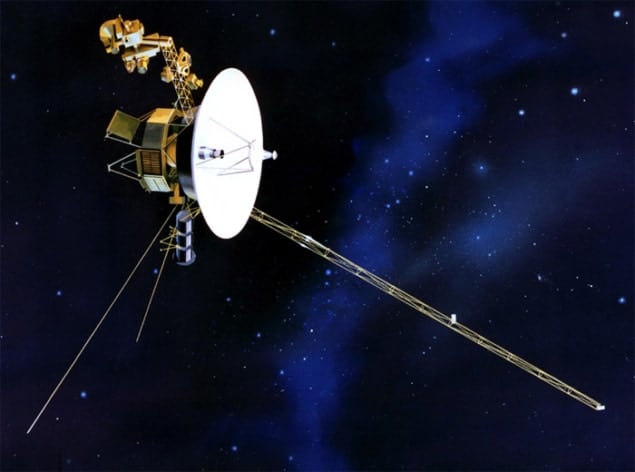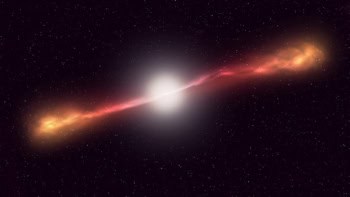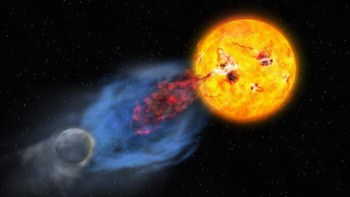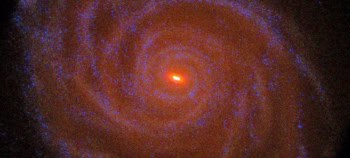
Using recently released data from the Voyager I satellite mission, researchers in the US have developed a new and accurate formula that describes the Sun’s influence on cosmic rays. Cosmic rays – extremely high-energy charged particles that originate outside of the solar system and travel at nearly light-speed – are studied by numerous experiments because they shed light on some of the most violent phenomena in the universe. The researchers hope that their formula will improve the analysis of cosmic-ray data, by better predicting how these particles are affected by solar wind.
First discovered in 1912 by physicist Victor Hess during a daring hot-air-balloon flight, cosmic rays are constantly bombarding the Earth’s atmosphere, producing showers of secondary particles that even sometimes reach the surface. Cosmic rays are mainly made up of high-energy protons and atomic nuclei. Their origin is still something of a mystery, although recent experimental data from the Fermi Space Telescope have shown that many of them originate from supernovae, while some may come from quasars. Almost all of our observations of cosmic rays are carried out within the heliosphere – the massive magnetic bubble that extends well beyond Pluto’s orbit and contains the solar system.
Solar force field
When the idea of “solar wind” was developed in the early 1960s, researchers realized that cosmic rays would be modulated by the magnetic field embedded within the wind, and developed some formulas to account for this effect. Known as the “force-field approximation”, it takes into consideration the final observed energy of the cosmic rays when they reach the Earth and of the energy of cosmic rays in the surrounding interstellar medium (ISM) – the matter that exists between star systems in a galaxy and is therefore outside of the heliosphere.
While the force-field approximation has been widely employed since 1968, it has several weaknesses. The most important shortcoming is the fact that it does not take into account the strong correlation between the solar modulation and changing solar activity. In fact, the modulation is charge-dependent and varies over time, over a scale of months to years – something that the approximation does not consider.
Understanding the effects of solar modulation is one of the science goals for both the Payload for Antimatter/Matter Exploration and Light-nuclei Astrophysics (PAMELA) experiment and the Alpha Magnetic Spectrometer (AMS), which study cosmic rays in space. Thanks to the detailed and continuous measurements of cosmic rays made by both of these experiments, researchers can now see how the cosmic-ray spectrum changes over relatively short timescales with high statistical precision. Also, recently released data from the Voyager 1 spacecraft – which has most likely left the solar system and is beyond the heliopause – has provided the first measurements of cosmic rays that are unaffected by the solar wind, in the ISM.
Magnetic morphology
Thanks to these advances, Ilias Cholis from Johns Hopkins University in Baltimore, together with colleagues at the Fermi National Accelerator Laboratory and the University of Chicago, has built on the force-field approximation, as well as other simulations done by other groups in the past decade, to refine the modulation formula. Cholis says that the approximation’s simplifying assumptions have been challenging the data from recent experiments. “We now are confident that particles of different charge get affected differently by the embedded field of the solar wind,” he says, explaining that their new formula takes into account previously unknown physical phenomena within the wind. “Also the morphology of the magnetic field within the heliosphere is an important aspect of the problem, as is the energy of the cosmic-ray particles and the time it takes them to propagate form the interstellar medium to the position of the Earth were we observe cosmic rays.”
The team analysed cosmic-ray data, collected by many balloon experiments, from AMS-02 and PAMELA, and also from Voyager 1, over 24 years. The researchers also took into consideration solar-wind data of the last two decades to account for the time dependence of the embedded magnetic field – something that has not been done before.
Seasonal variations
Cholis told physicsworld.com that their final formula for the solar modulation potential accounts for the fact that different cosmic rays with different charge and energy experience a time-varying magnetic field within solar wind. “Since we continuously monitor the solar-wind properties, we will be able to know (within some remaining uncertainty) at a given time what the solar modulation potential will be for particles of given charge and energy. As more data will be collected by AMS-02 over the next decade, those remaining uncertainties will be probed and further constrained,” he adds.
One of the main aims of the AMS-02 experiment is to detect antimatter cosmic rays, which are thought to be produced by annihilating dark-matter particles. Cholis and colleagues hope their formula will help the AMS researchers to reduce systematic uncertainties that crop up in the measurements.
The research is published in Physical Review D.



